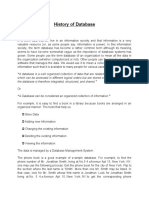History of Database
History of Database
Uploaded by
Ar Ey Way EmCopyright:
Available Formats
History of Database
History of Database
Uploaded by
Ar Ey Way EmCopyright
Available Formats
Share this document
Did you find this document useful?
Is this content inappropriate?
Copyright:
Available Formats
History of Database
History of Database
Uploaded by
Ar Ey Way EmCopyright:
Available Formats
Asuncion Raymante CS-3 / IT131 BC-2
History of Database
A database is an organized collection of data. The term database is applied to the data and their supporting data structures, and not to the database management system (DBMS). The database data collection with DBMS is called a database system. Originally DBMSs were found only in large organizations with the computer hardware needed to support large data sets. Database has been in use since the earliest days of electronic computing. Unlike modern systems, which can be applied to widely different databases and needs the vast majority of older systems were tightly linked to the custom databases in order to gain speed at the expense of flexibility. As computers grew in speed and capability a number of general-purpose database systems emerged by the mid-1960s. There were two popular data models in this decade: a network model called CODASYL and a hierarchical model called IMS. One database system that proved to be a commercial success was the SABRE system that was used by IBM to help American Airlines manage its reservations data. Years after that major relational database system prototype were created and they were the Ingres, which was developed at UBC, and System R, created at IBM San Jose. Ingres used a query language known as QUEL, and it led to the creation of systems such as Ingres Corp., MS SQL Server, Sybase, Wangs PACE, and Britton-Lee. On the other hand, System R used the SEQUEL query language, and it contributed to the development of SQL/DS, DB2, Allbase, Oracle, and Non-Stop SQL. It was also in this decade that Relational Database Management System, or RDBMS, became a recognized term. Relational database systems became a commercial success as the rapid increase in computer sales boosted the database market and this caused a major decline in the popularity of network and hierarchical database models. DB2 became the flagship database product for IBM and the introduction of the IBM PC resulted in the establishments of many new database companies and the development of products such as PARADOX, RBASE 5000, RIM, Dbase III and IV, OS/2 Database Manager, and Watcom SQL. Although the Internet industry experienced a decline in the early 2000s, database applications continue to grow. New interactive applications were developed for PDAs, point-of-sale transactions, and consolidation of vendors. Presently, the three leading database companies in the western world are Microsoft, IBM, and Oracle
Asuncion Raymante CS-3 / IT131 BC-2
You might also like
- Database AssignmentDocument8 pagesDatabase AssignmentWidimongar W. JarqueNo ratings yet
- Automate DBA Tasks With AnsibleDocument60 pagesAutomate DBA Tasks With Ansibledensity449673No ratings yet
- History and Background of DatabaseDocument16 pagesHistory and Background of Databasealikasim04451530No ratings yet
- History of Data BaseDocument12 pagesHistory of Data BaseJhia Mae GoNo ratings yet
- Database Lesson 1 To 5Document10 pagesDatabase Lesson 1 To 5cabalidarealynNo ratings yet
- DBMS Detailed ProjectDocument20 pagesDBMS Detailed ProjectVibHor GaRgNo ratings yet
- Vibhor File 1Document20 pagesVibhor File 1VibHor GaRgNo ratings yet
- Learning Computing HistoryDocument12 pagesLearning Computing HistorySajid Ali LaghariNo ratings yet
- Final Report of DbmsDocument24 pagesFinal Report of DbmsRohit KaliaNo ratings yet
- Database Management SystemDocument36 pagesDatabase Management SystemAmishi TrivediNo ratings yet
- DatabaseDocument106 pagesDatabaseRakesh K R100% (2)
- Assignment 1,2Document18 pagesAssignment 1,2Saubhagya VardhanNo ratings yet
- Database PDFDocument22 pagesDatabase PDFAnanya GetahunNo ratings yet
- Database PDFDocument106 pagesDatabase PDFiki292No ratings yet
- Data Design and Modeling Database Management System Software End UsersDocument18 pagesData Design and Modeling Database Management System Software End Usersmk browsingNo ratings yet
- It Assignment DbmsDocument12 pagesIt Assignment Dbmshamidu2No ratings yet
- Database MaterialDocument29 pagesDatabase MaterialolalemidunsinNo ratings yet
- U1 - History of Database SystemsDocument14 pagesU1 - History of Database SystemsharshaavenkatasalapathiNo ratings yet
- History of DatabasesDocument5 pagesHistory of DatabasesFaisal JafferNo ratings yet
- Data Design and Modeling Database Management System Software End UsersDocument15 pagesData Design and Modeling Database Management System Software End UsersSanket SahuNo ratings yet
- Database Management System: ProgramDocument9 pagesDatabase Management System: ProgramShannett WalcottNo ratings yet
- DatabaseDocument23 pagesDatabasegemechu gebisaNo ratings yet
- Chapter 8Document13 pagesChapter 8Shelly EfedhomaNo ratings yet
- DatabaseDocument5 pagesDatabaseDAKSH GREAD DPSN-STDNo ratings yet
- Trends in Database SoftwareDocument11 pagesTrends in Database SoftwareAjit DhainjeNo ratings yet
- Dbms Unit-1 Notes For StudentsDocument79 pagesDbms Unit-1 Notes For Studentsbharath KumarNo ratings yet
- History of Database Management SystemsDocument7 pagesHistory of Database Management SystemsvinodtiwarivtNo ratings yet
- BSC It Dbms NotesDocument187 pagesBSC It Dbms Notesapi-28688504673% (11)
- TimelineDocument2 pagesTimelinegpsigmaNo ratings yet
- Database: An Example of Output From An SQL Database QueryDocument18 pagesDatabase: An Example of Output From An SQL Database QueryKarthik KatakamNo ratings yet
- DatabaseDocument15 pagesDatabasekanojiyanikhil034No ratings yet
- Databases On Linux: Linux Fundamentals and AdmiistrationDocument6 pagesDatabases On Linux: Linux Fundamentals and AdmiistrationCLARICE BONIFACIONo ratings yet
- Database AssignmentDocument8 pagesDatabase AssignmentWidimongar JarqueNo ratings yet
- DBMS Unit1 NotesDocument40 pagesDBMS Unit1 NotesMonika reddy ReddyNo ratings yet
- Dbms 7Document1 pageDbms 7Vidya JananiNo ratings yet
- History of Database Management SystemsDocument7 pagesHistory of Database Management SystemsAnoshKhanNo ratings yet
- Database Cocepts and Evolution (Summary)Document1 pageDatabase Cocepts and Evolution (Summary)Rupak SinghNo ratings yet
- Database Management System: Prof. Dr. O.P.VyasDocument188 pagesDatabase Management System: Prof. Dr. O.P.VyasAbhishek JhaNo ratings yet
- History of DatabaseDocument74 pagesHistory of DatabaseNisha Pal0% (1)
- Oracle Material-Latest PDFDocument330 pagesOracle Material-Latest PDFjagadeeshNo ratings yet
- Oracle New Material-UpdatedDocument330 pagesOracle New Material-UpdatedLakshmi Kanth100% (5)
- Relational Database Management SystemDocument3 pagesRelational Database Management SystemUtkarsh KaharNo ratings yet
- Evolution of Database Management SystemsDocument1 pageEvolution of Database Management SystemssuryaNo ratings yet
- Users: Citation NeededDocument29 pagesUsers: Citation NeededBadri NarayananNo ratings yet
- Management Information System AssignmentDocument6 pagesManagement Information System AssignmentAnooja Sajeev0% (1)
- Dbms MBA NotesDocument125 pagesDbms MBA NotesAnoop Skaria Paul50% (2)
- Database Management SystemDocument12 pagesDatabase Management SystemTaniya SethiNo ratings yet
- IntroToDbms-Test1NotesDocument14 pagesIntroToDbms-Test1NotesPranav KakadeNo ratings yet
- Database Management - Class NotesDocument6 pagesDatabase Management - Class NotesAnooja SajeevNo ratings yet
- Dbms 3Document1 pageDbms 3Vidya JananiNo ratings yet
- Database Programming: CPC 223 (A)Document80 pagesDatabase Programming: CPC 223 (A)Tykes MendozaNo ratings yet
- Database Trends - Past, Present, FutureDocument59 pagesDatabase Trends - Past, Present, FutureJason SuttonNo ratings yet
- Database System: Some Application ProgramsDocument8 pagesDatabase System: Some Application ProgramsSwati SinghNo ratings yet
- IS in ITDocument19 pagesIS in ITEmman EscullarNo ratings yet
- DBMS Final (1-5-113)Document98 pagesDBMS Final (1-5-113)Prameela KNo ratings yet
- Database Management System: This Article Has Multiple Issues. Please HelpDocument11 pagesDatabase Management System: This Article Has Multiple Issues. Please HelpTanushri GhoshNo ratings yet
- Course SQLDocument5 pagesCourse SQLVamsi SrimathirumalaNo ratings yet
- Jump Start MySQL: Master the Database That Powers the WebFrom EverandJump Start MySQL: Master the Database That Powers the WebNo ratings yet
- Module 15 - Synonyms, Sequences and ViewsDocument17 pagesModule 15 - Synonyms, Sequences and ViewsGautam TrivediNo ratings yet
- Literature Review On Big DataDocument10 pagesLiterature Review On Big DataCandraNo ratings yet
- Oracle 1Z0-434 Dumps With Valid 1Z0-434 Exam Questions PDF (2018)Document5 pagesOracle 1Z0-434 Dumps With Valid 1Z0-434 Exam Questions PDF (2018)Hari Haran MNo ratings yet
- Mohit Kumar-ProfileDocument6 pagesMohit Kumar-ProfileARPIT VERMANo ratings yet
- Reference Book: "Enterprise Systems For Management": Implementation StrategiesDocument19 pagesReference Book: "Enterprise Systems For Management": Implementation StrategiesKay KhineNo ratings yet
- WWW Minipa Com BR Produtos CompareResultado-FONTES DUPLADocument1 pageWWW Minipa Com BR Produtos CompareResultado-FONTES DUPLAKrista TranNo ratings yet
- Hermans K. Mastering IT Auditing.A Comprehensive Guide To Learn IT Auditing 2023Document285 pagesHermans K. Mastering IT Auditing.A Comprehensive Guide To Learn IT Auditing 2023Karoly SoosNo ratings yet
- Advanced Computer Architecture: Program Flow MechanismsDocument14 pagesAdvanced Computer Architecture: Program Flow Mechanismskpriya8687No ratings yet
- The Forrester Wave-Master Data Management Solutions, Q1 2014Document17 pagesThe Forrester Wave-Master Data Management Solutions, Q1 2014Pallavi ReddyNo ratings yet
- Server Crash TroubleshootingDocument35 pagesServer Crash Troubleshootingsvinoth1981No ratings yet
- Linked List: Method To Insert (Add) A Node in The Beginning of A Linked ListDocument6 pagesLinked List: Method To Insert (Add) A Node in The Beginning of A Linked ListBanani BhattacharyaNo ratings yet
- JacORB - ProgrammingGuideDocument149 pagesJacORB - ProgrammingGuideRino SminchioNo ratings yet
- 1.5 Extreme ProgrammingDocument12 pages1.5 Extreme ProgrammingMohamed BilalNo ratings yet
- Cybercon V1.0: Submitted By, Shoaib Mohammed A, Ii B.E. EeeDocument14 pagesCybercon V1.0: Submitted By, Shoaib Mohammed A, Ii B.E. EeeAnanda SureshNo ratings yet
- Introduction To ASPDocument23 pagesIntroduction To ASPVenkat Uma MaheshwaraoNo ratings yet
- Online Movie Ticket System - AzajDocument14 pagesOnline Movie Ticket System - AzajAzaj Khan75% (12)
- Noc19 cs32 Assignment10Document4 pagesNoc19 cs32 Assignment10Pallab ChakrabortyNo ratings yet
- Deployment Guide - Provance IT Asset Management Pack PDFDocument24 pagesDeployment Guide - Provance IT Asset Management Pack PDFdebajyotiguhaNo ratings yet
- Server 2016 SQL Always Encrypted Integration GuideDocument44 pagesServer 2016 SQL Always Encrypted Integration GuidefilipeNo ratings yet
- 3 Tier ArchitectureDocument19 pages3 Tier Architecturesash_8No ratings yet
- Ee Draindumps 2024-Jan-25 by Elijah 198q VceDocument15 pagesEe Draindumps 2024-Jan-25 by Elijah 198q Vcesagarjob2016No ratings yet
- PostgreSQL For Data Architects - Sample ChapterDocument23 pagesPostgreSQL For Data Architects - Sample ChapterPackt PublishingNo ratings yet
- KDSSG Center For Excellence: SQL Server 2005 DBA Installation ChecklistDocument5 pagesKDSSG Center For Excellence: SQL Server 2005 DBA Installation ChecklistrameshNo ratings yet
- Reema Karajgaonkar Mob: - +91 9704961457: Infosys Technologies LimitedDocument4 pagesReema Karajgaonkar Mob: - +91 9704961457: Infosys Technologies LimitedVaibhav KarajgaonkarNo ratings yet
- SEED Hackathon 2024 - GDG IEMDocument2 pagesSEED Hackathon 2024 - GDG IEMIndrava ChowdhuryNo ratings yet
- Integrating Security No Pain RequiredDocument12 pagesIntegrating Security No Pain Requiredbmystik3kNo ratings yet
- Tahir Aslam CVDocument3 pagesTahir Aslam CVasadnawazNo ratings yet
- WAD 04 - Javascript - Loop - ArrayDocument13 pagesWAD 04 - Javascript - Loop - ArrayDayana KemeskyNo ratings yet
- RoadMap Mern StackDocument10 pagesRoadMap Mern Stackنیان سیف باٹھNo ratings yet

























































































